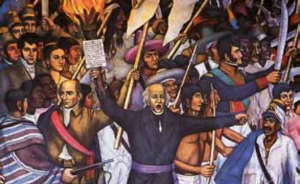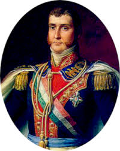The Campaign for Mexican Independence
A long time coming, Mexican independence was the result of an 11-year insurgency led by soldiers, religious leaders, and the general population. Mexico was officially free from Spanish "ownership" in 1821. 
Spanish explorations of North America and South America had begun in the early 16th Century and continued for many years. Eventually, Spain controlled a large amount of territory that it referred to as New Spain. What is today Mexico was part of that after the Spanish conquest of the Aztec Empire in 1521. Spain was deep in the throes of the Napoleonic Wars in the first decade of the 19th Century. In 1808, French troops occupied Spain and installed Napoleon's brother Joseph on the Spanish throne. A gritty civil war ensued, and Spain was more concerned with its own borders than with those of territories in the New World. Spain had organized New Spain as a territory under strict control from the monarchy in Spain. Local councils took care of administration, but the crown determined such things as property ownership and taxation. As well, the people who lived in New Spain were under a class system that was determined along racial lines: Spanish-born residents were at the top of the heap, followed by American-born citizens of Spain, followed by people who had both Spanish and Native American ancestry; at the bottom were Native Americans. The top class of people held all the power, and everyone else resented this status, in varying degrees. The lower three classes began to agree more and more as the 19th Century progressed, and one of the things that they increasingly agreed on was the need for Mexico to be independent from Spain. Spain had put down a number of uprisings in the previous few centuries and also had a reputation for dominance, backed up by superior technology, in its assimilation of Native American cultures, particularly in South America. Spanish rulers and soldiers still had a large amount of weapons and ammunition in the early 19th Century. What the lower three classes had was a large number of people who were increasingly expressing a passion for going their own way. Inspiring them was the Virgin of Guadalupe, an indigenous patron saint whose skin color was not white. Depictions of her appeared on banners borne by those in rebellion. 
The first significant event in the drive toward Mexican independence was a call from a religious figure. Miguel Hidalgo y Costilla, a Catholic priest born in Mexico, urged his parishioners to rise up and throw off the Spanish yoke on Sept. 16, 1810. He made this plea in the town of Dolores, in which he was the priest at the time. This became known as the Grito de Dolores, or "Cry of Dolores." Hidalgo, a well-known theologian, had offered his home as a setting for secret meetings to discuss independence. Among his associates was the well-known military Ignacio Allende. The ground was already laid, and Hidalgo's public call for a revolt was met with enthusiasm by several hundred people right away. Hidalgo made it clear that anyone who wanted to rise up against Spain was welcome in his movement. Members of all of the lower classes joined the movement. Following the lead of Hidalgo and Allende, the group, which numbered about 600 within a few days, set off in search of Spaniards to target. Rebel numbers swelled rapidly; and by the time the force reached Guanajuato on September 28, it was 30,000. Spanish soldiers who had had word of the impending attack had barricaded themselves inside a granary; the mob stormed the granary, resulting in the deaths of more than 500, and continued on to the capital, Mexico City. Skirmishes between ruling and ruled continued, as Spain scrambled to respond to a situation that was rapidly spinning out of control. The next large confrontation was on October 30, at the Battle of Monte de las Cruces. Again, Hidalgo's force emerged victorious, in the process seizing a number of cannons. On the verge of entering Mexico City and pressing his case for the overthrow of the royal governor, Hidalgo decided against such a move. Following Hidalgo's lead, the mob suddenly dispersed, spreading out across the surrounding countryside. Some rebels continued to fight, but the tide had turned. Spanish forces won the Battle of the Bridge of Calderón in January 1811, setting the insurgents on a path of flight. A resurgent Spanish army captured the rest of the rebels, including Hidalgo, in the state of Coahuila. Allende and other soldiers were summarily executed. Hidalgo underwent public humiliation at the hands of the Inquisition and was then killed. The revolutionary spirit was still alive in many Mexicans, however, and José María Morelos, a secular priest like Hidalgo, assumed leadership of the rebellion. In yet another change in momentum, Morelos inspired his forces to take the fight again to the Spanish, succeeding in taking over the large cities of Acapulco and Oaxaca. Looking to find further inspiration for the insurgency, Morelos called a meeting of rebels from various parts of the country. The Congress of Chilpancingo began on November 6, and the result was the Solemn Act of the Declaration of Independence of Northern America. The war continued. Morelos himself was captured in 1815 and, like rebel leaders before him, tried for treason and convicted and executed. The rebellion was fueled by not only the desire for independence but also the memory of Hidalgo and his leadership and martyrdom. The numbers of fighters and weapons on both sides had diminished by this time, and the next few years featured much less military activity but a slight increase in guerrilla fighting on the behalf of the insurgency and yet another new leader, Vicente Guerrero. 
A key development came in 1820, when Agustín de Iturbide (right), a Spanish soldier who had helped defeat Hidalgo, switched sides. The Spanish monarch had been overthrown, and many in New Spain thought that they would fare better as an independent entity. Seeking to ensure an orderly transition, the leaders of the rebellion met with Iturbide and other soldiers and agreed on the Plana de Iguala, which set out the blueprint for a new government, a constitutional monarchy independent from Spain that would guarantee political and social equality among all of its citizens. The long civil war ended on September 27, 1821, when representatives of the rebellion and the government signed the Treaty of Cordoba. Iturbide was named President of the Regency and, the following year, was the first Constitutional Emperor of Mexico. The constitutional monarchy had a short life. Another rebellion, led by Antonio López de Santa Anna and Guadalupe Victoria, in 1823 overthrew the emperor and established the Mexican Republic. Spain officially recognized Mexico's independence in 1836.
|
|
Social Studies for Kids
copyright 2002–2024
David White




